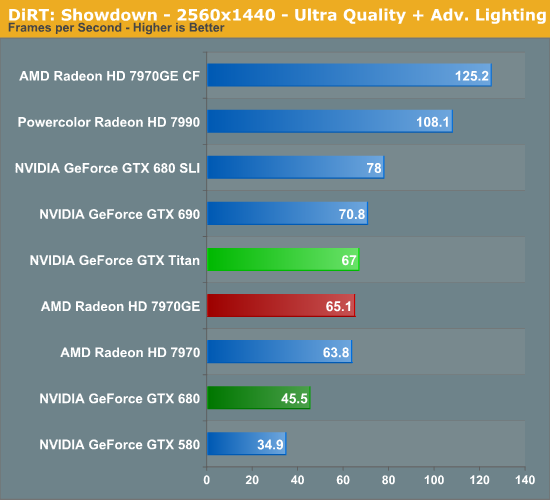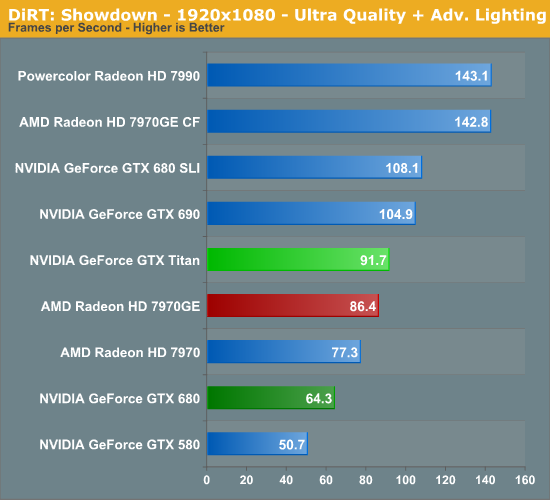NVIDIA’s GeForce GTX Titan Review, Part 2: Titan's Performance Unveiled
by Ryan Smith & Rahul Garg on February 21, 2013 9:00 AM ESTDiRT: Showdown
Racing to the front of our 2013 list will be our racing benchmark, DiRT: Showdown. DiRT: Showdown is based on the latest iteration of Codemasters’ EGO engine, which has continually evolved over the years to add more advanced rendering features. It was one of the first games to implement tessellation, and also one of the first games to implement a DirectCompute based forward-rendering compatible lighting system. At the same time as Codemasters is by far the most prevalent PC racing developers, it’s also a good proxy for some of the other racing games on the market like F1 and GRID.




DiRT: Showdown is something of a divisive game for benchmarking. The game’s advanced lighting system, while not developed by AMD, does implement a lot of the key concepts they popularized with their Leo forward lighting tech demo. As a result performance with that lighting system turned on has been known to greatly favor AMD cards. With that said, since we’re looking at high-end cards there’s really little reason not to be testing with it turned on since even a slow card can keep up. That said, this is why we also test DiRT with advanced lighting both on and off starting at 1920x1080 Ultra.
The end result is perhaps unsurprising in that NVIDIA already starts with a large deficit with the GTX 680 versus AMD’s Radeon cards. Titan closes the gap and is enough to surpass the 7970GE at every resolution except 5760, but just barely. This is the one game like this and as a result I don’t put a ton of stock into these results on a global level, but I thought it would make for an interesting look none the less.
This also settles some speculation of whether DiRT and its compute-heavy lighting system would benefit from the compute performance improvements Titan brings to the table. The answer to that is yes, but only by roughly as much as the increase in theoretical compute performance over GTX 680. We’re not seeing any kind of performance increase that could be attributed to improved compute efficiency here, which is why Titan can only just beat the 7970GE at 2560 here. However the jury is still out on whether this means that DiRT’s lighting algorithm doesn’t map well to Kepler period, or if it’s an implementation issue. We also saw some unexpected weak DirectCompute performance out of Titan with our SystemCompute benchmark, so this may be further evidence that DirectCompute isn’t currently taking full advantage of everything Titan offers.
In any case, at 2560 Titan is roughly 47% faster than the GTX 680 and all of 3% faster than the 7970GE. It’s enough to get Titan above the 60fps mark here, but at 5760 no single GPU, not even GK110, can get you 60fps. On the other hand, the equivalent AMD dual-GPU products, the 7970GECF and the 7990, have no such trouble. Dual-GPU cards will consistently win, but generally not like this.










337 Comments
View All Comments
etriky - Sunday, February 24, 2013 - link
OK, after a little digging I guess I shouldn't be to upset about not having Blender benches in this review. Tesla K20 and GeForce GTX TITAN support was only added to Blender on the 2/21 and requires a custom build (it's not in the main release). See http://www.miikahweb.com/en/blender/svn-logs/commi... for more infoRyan Smith - Monday, February 25, 2013 - link
As noted elsewhere, OpenCL was broken in the Titan launch drivers, greatly limiting what we could run. We have more planned including SLG's LuxMark, which we will publish an update for once the driver situation is resolved.kukreknecmi - Friday, February 22, 2013 - link
If you look at Azui's PDF, with using different type of kernel , results for 7970 are :SGEMM : 2646 GFLOP
DGEMM : 848 GFLOP
Why did u take the lowest numbers for 7970 ??
codedivine - Friday, February 22, 2013 - link
This was answered above. See one of my earlier comments.gwolfman - Friday, February 22, 2013 - link
ASUS: http://www.newegg.com/Product/Product.aspx?Item=N8...OR
Titan gfx card category (only one shows up for now): http://www.newegg.com/Product/ProductList.aspx?Sub...
Anand and staff, post this in your news feed please! ;)
extide - Friday, February 22, 2013 - link
PLEASE start including Folding@home benchmarks!!!TheJian - Sunday, February 24, 2013 - link
Why? It can't make me any money and isn't a professional app. It tells us nothing. I'd rather see photoshop, premier, some finite analysis app, 3d Studiomax, some audio or content creation app or anything that can be used to actually MAKE money. They should be testing some apps that are actually used by those this is aimed at (gamers who also make money on their PC but don't want to spend $2500-3500 on a full fledged pro card).What does any card prove by winning folding@home (same with bitcoin crap, botnets get all that now anyway)? If I cure cancer is someone going to pay me for running up my electric bill? NOPE. Only a fool would spend a grand to donate electricity (cpu/gpu cycles) to someone else's next Billion dollar profit machine (insert pill name here). I don't care if I get cancer, I won't be donating any of my cpu time to crap like this. Benchmarking this proves nothing on a home card. It's like testing to see how fast I can spin my car tires while the wheels are off the ground. There is no point in winning that contest vs some other car.
"If we better understand protein misfolding we can design drugs and therapies to combat these illnesses."
Straight from their site...Great I'll make them a billionaire drug and get nothing for my trouble or my bill. FAH has to be the biggest sucker pitch I've ever seen. Drug companies already rip me off every time I buy a bottle of their pills. They get huge tax breaks on my dime too, no need to help them, or for me to find out how fast I can help them...LOL. No point in telling me sythentics either. They prove nothing other than your stuff is operating correctly and drivers set up right. Their perf has no effect on REAL use of products as they are NOT a product, thus not REAL world. Every time I see the word synthetic and benchmark in the same sentence it makes me want to vomit. If they are limited on time (usually reviewers are) I want to see something benchmarked that I can actually USE for real.
I feel the same way about max fps. Who cares? You can include them, but leaving out MIN is just dumb. I need to know when a game hits 30fps or less, as that means I don't have a good enough card to get the job done and either need to spend more or turn things down if using X or Y card.
Ryan Smith - Monday, February 25, 2013 - link
At noted elsewhere, FAHBench is in our plans. However we cannot do anything further until NVIDIA fixes OpenCL support.vanwazltoff - Friday, February 22, 2013 - link
the 690, 680 and 7970 have had almost a year to brew and improve with driver updates, i suspect that after a few drivers and an overclock titan will creep up on a 690 and will probably see a price deduction after a few months. dont clock out yet, just think what this could mean for 700 and 800 series cards, its obvious nvidia can deliverTheJian - Sunday, February 24, 2013 - link
It already runs 1150+ everywhere. Most people hit around 1175 max OC stable on titan. Of course this may improve with aftermarket solutions for cooling but it looks like they hit 1175 or so around the world. And that does hit 690 perf and some cases it wins. In compute it's already a winner.If there is no die shrink on the next gens from either company I don't expect much. You can only do so much with 250-300w before needing a shrink to really see improvements. I really wish they'd just wait until 20nm or something to give us a real gain. Otherwise will end up with a ivy,haswell deal. Where you don't get much (5-15%). Intel won't wow again until 14nm. Graphics won't wow again until the next shrink either (full shrink, not the halves they're talking now).